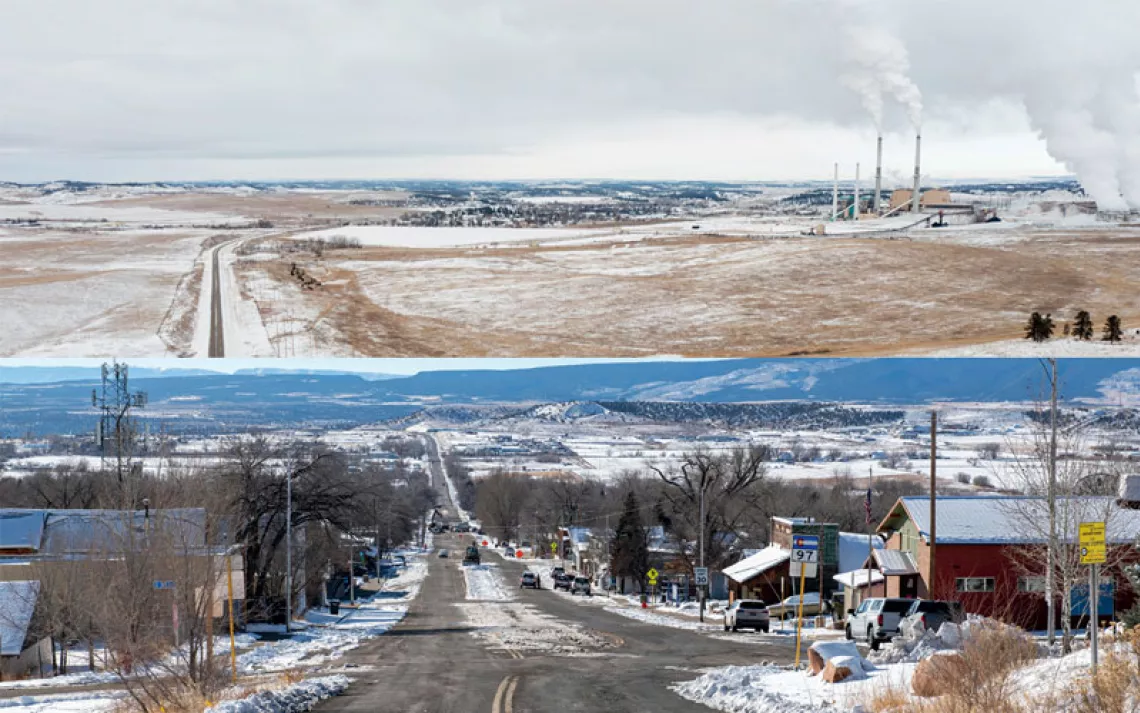Strip Mine Holiday
A mountaintop-removal coal mine threatens Fayetteville's new outdoor-adventure economy
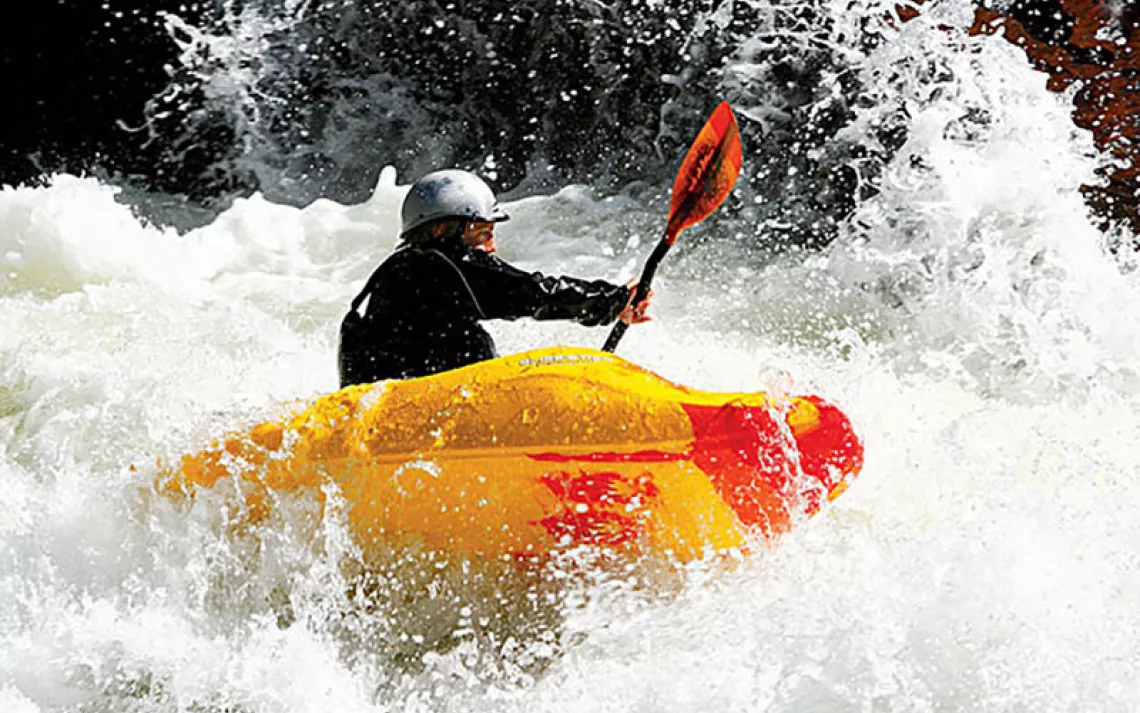
A kayaker at Pillow Rock on the Upper Gauley River in West Virginia. | Photography by Harrison Shull
A DENSE MORNING FOG SWARMS the New River Gorge in Fayetteville, West Virginia. Rafters and kayakers, already soaked and indifferent to the drizzle, navigate turbulent rapids, while hundreds of feet above them climbers take refuge beneath rock overhangs within earshot of cascading waterfalls. In the forested gorge between river runners and climbers, a coal train weaves its way south, its rumble echoing through the valley.
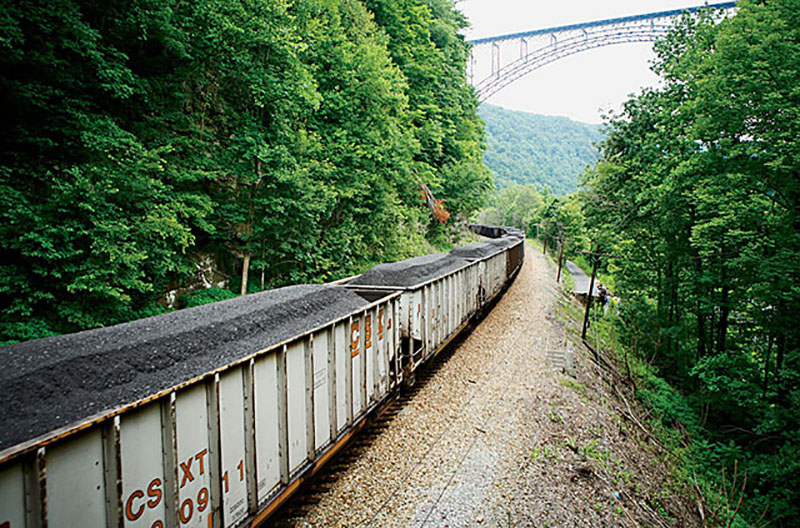
A coal train runs under the iconic bridge across the New River Gorge.
Perched on the rim of the New River Gorge and a short drive from the Gauley River, the town of Fayetteville has become one of the country's top outdoor destinations. In addition to the world-class whitewater and impeccable sandstone, there are some of the best hiking, mountain-biking, and running trails in the state. Before its reincarnation as an outdoor-adventure mecca, Fayetteville suffered the boom and bust of resource extraction. Through the early 20th century, the timber and coal industries ripped through the heart of the gorge, leaving ghost towns in their wake. Though the forest has since grown back, remnants of coal camps that were abandoned mid-century still dot the gorge's upper banks, and train tracks line both sides of the river.
It wasn't until the late 1960s that serious boaters discovered the region's classic whitewater. Then climbers began scouting the surrounding cliffs. Together they transformed the local economy and revitalized the area.
"Without recreation, we'd be hurting. We'd be dead," says Ray St. Clair, a 59-year-old West Virginia native, former coal miner, and co-owner of Ray's Campground, which lies between the Gauley River and the New River Gorge. In the mines, St. Clair was a fire boss, checking gas and oxygen levels and throwing rock dust over combustible coal dust between shifts. But in 1985 the New River Company mine in Stanaford shut down, and St. Clair leased a campground that catered to rafters, climbers, and vacationing families. As the region became more popular, he and his wife built their own campground. "We've been able to make a living at it," he says.
Now, however, the coal industry is threatening a comeback: Frasure Creek Mining is proposing a major expansion of its mountaintop-removal coal operation right in the center of Fayette County. "It basically surrounds Fayetteville and the New River," says Stephanie Tyree, a community organizer with the Ohio Valley Environmental Coalition, "and is creeping closer."
Those who make their living in sustainable tourism fear the worst. "From my perspective as a business owner," says Kenny Parker, co-owner of an outdoor-gear shop, "just the perception out there in mainstream America that West Virginia is this land of devastation and destruction might deter people from traveling here."
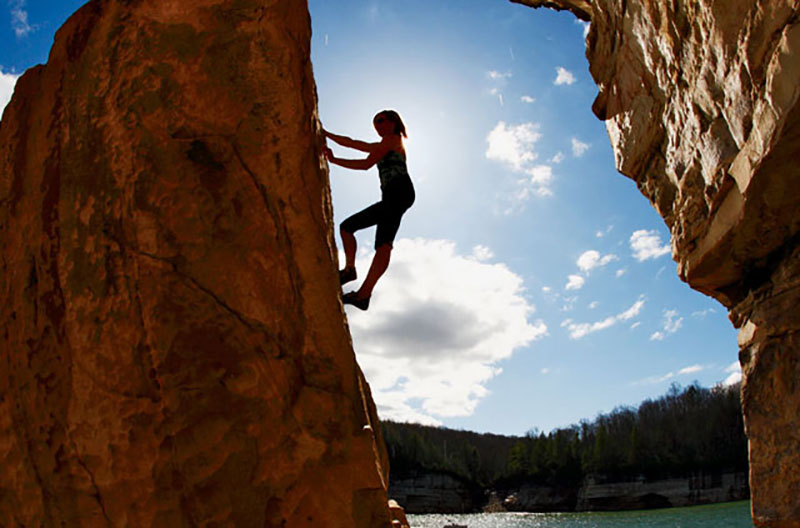
Bouldering on the dry bed of Summersville Lake.
In the early days, locals didn't know how to react to visitors who came to raft the roaring rivers or climb steep cliffs for the hell of it. Even 40 years after out-of-state adventurers started infiltrating the area, cultures still clash. "A lot of people just think that raft people, in general, are trash—hippie, smoke weed, drink, party, don't want to work," St. Clair says. "But the vast majority are not like that at all. They're honest, good people. They just [run the river] because they like it."
Clif Bobinski arrived in Fayetteville in the late 1970s and started guiding raft trips on the Gauley and New Rivers in 1979. At the time, he says, "Fayetteville was trying to decide whether boaters were total fr eak shows or what. Anybody from out of state was considered strange, especially people who wanted to run the river." Though he left for a 10-year stint with the Bureau of Land Management in Arizona, he returned because these are his "home rivers." Today, Bobinski is a planner for the New River Gorge National River, the 70,000-acre National Park Service unit northeast of town. Local acceptance of the whitewater industry has increased, he claims, now that multiple generations have profited from it. Once the coal mines shut down, he says, "tourism seemed like the new way to try to make it and stay. Now a lot of restaurants are dependent on that business. We have places celebrating Cinco de Mayo and having burrito-eating contests."
The influx of outdoor enthusiasts has influenced Fayetteville's culture in other ways as well. Before the tourism boom, many downtown storefronts stood vacant; now they house a yoga studio, a bead shop, art galleries, multiethnic cafes, and numerous biking, climbing, and whitewater shops.
THE HARDWARE STORE AND THE PHARMACY, with its old-fashioned soda fountain, are gone, but a century-old bank and the Fayette County Courthouse remain, and the historic Fayette Theater still hosts plays and concerts. Just a few blocks from downtown is the town park, at the rear of which a trail disappears into the forest, dropping into the New River Gorge.
"The playground is right out your back door," says Parker, a scruffy 48-year-old climber who first visited the area in 1985 after an article in Climbing magazine extolled its potential. Until then, the surrounding crags had been known only to a handful of locals. Today, the area's 1,400 routes are internationally famous. Parker moved to Fayetteville in 1994 to open a climbing shop and guide service. He's climbed all over the world, but says the Nuttall sandstone cliffs of the New River Gorge are unmatched. "As far as consistent quality of rock, cragging, and one-pitch climbing go, it's as good as it gets," he says. "There are miles and miles of quality routes, more than you could ever do."
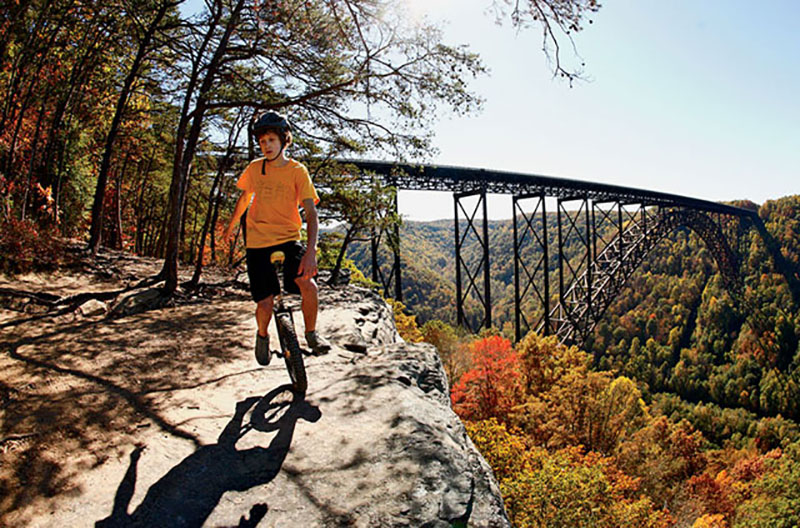
One-wheel mountain biking on the north rim of the gorge near Fayetteville.
The New River Gorge encompasses 70,000 acres and in most places is 1,000 feet deep, studded with rock cliffs where climbers are barely visible to the rafters and kayakers below. Massive boulders line the banks of the river, corralling the water. The latter half of the Lower New River—the premier paddling section of the gorge—takes out minutes from Fayetteville. Its 6.5 miles feature 10 Class IV and V rapids, but the water flow is bipolar; between exhilarating, tumultuous rapids with waves crashing at eye level are stretches of calm kick-back-and-have-a-beer currents.
The take-out on the Lower New is at Fayette Station, just before the impressive 876-foot-tall New River Gorge Bridge. Every October, Bridge Day—the "granddaddy" of all local events, as one guidebook describes it—brings close to 100,000 people to the New River Gorge Bridge to watch BASE jumpers and rappellers plunge into the gorge. In September, Gauley Fest, the largest whitewater festival in the world, attracts tens of thousands too. The New River rafting and kayaking season is pretty much year-round, but prime time at the Gauley River begins the first weekend after Labor Day, when the Army Corps of Engineers releases water from Summersville Dam. The Gauley drops 26 feet per mile—and a heady 48 feet per mile in the steepest sections—and features many more challenging rapids than the New River.
"When all the other rivers from New Zealand to California are pretty much dry, we have some of the best whitewater in the world," says Bobby Bower, executive director of the West Virginia Professional River Outfitters Association. "It's known around the world that the Gauley is running and it's the place to be."
Just outside town, the Arrowhead Trail, which opened last year, features more than 13 miles of winding, rolling-hill, single-track mountain-biking trails. Then there are the canopy zip-line tours, horseback riding, hiking, and fishing.
The Boy Scouts of America recently announced that its new 10,000-acre Summit Bechtel Family National Scout Reserve, 20 miles south of town, will host the National Scout Jamboree in 2013, attracting thousands of Scouts and their families. The World Jamboree is slated there for 2019, and the prospect of tens of thousands of visitors has local outfitters and business leaders salivating. But, some worry, will the crowds continue to flock to an area scarred by an enormous mountaintop-removal coal mine?
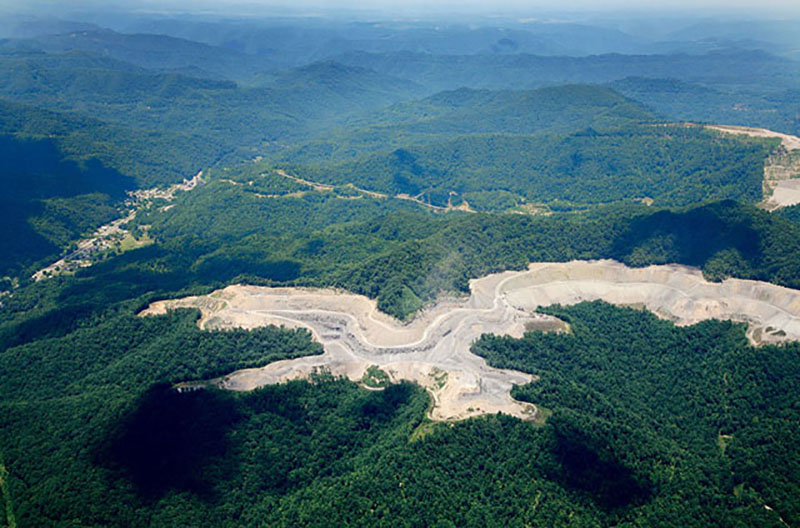
The west end of Frasure Creek's mountaintop-removal coal mine, above the town of Kincaid. The mine could grow vastly larger.
Frasure Creek Mining wants to carve a five-mile swath through Page-Kincaid, Beards Fork, and other communities west of Fayetteville along Route 61. The project would cover 3,662 acres and create 20 "valley fills"—dumping grounds for the mountains that are razed to get at the coal seams below. Frasure Creek Mining received its first permit for the site in January 2004; it now has three active permits covering 1,600 acres. Five other permits are under review, and one is pending appeal. If all nine permits are approved, they will essentially create one giant mountaintop-removal site.
"You see our state propaganda—'Wild and Wonderful'—everywhere," says the Ohio Valley Environmental Coalition's Tyree. "They paint this picture of how everything is beautiful, pristine, and protected. Yet, just in the back room, they are blowing up the mountains."
"They are definitely polluting the water," says Levi Rose, a watershed coordinator for the Plateau Action Network who manages the Wolf Creek Watershed, a classic paddling section in the gorge and a tributary to the Lower New. Rose recently analyzed all discharge reports from Frasure Creek Mining's Open Fork 1 mine from 2005 to 2010 and found nearly 100 violations. He also says that air pollution—primarily from diesel nitrate explosives—can make its way from the mine site to Fayetteville. Blasting can already be heard within the gorge, sometimes several times a day, and the strip mine is visible from high spots.
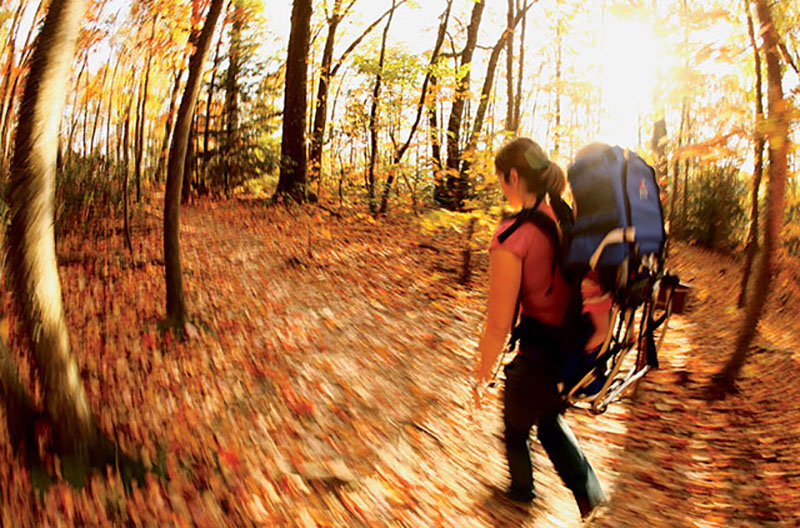
Two generations take in the Central Endless Wall atop the north rim of the New River Gorge.
Another source of contention is the mine's foreign ownership: Frasure Creek is a subsidiary of Trinity Coal, which is owned by the Indian conglomerate Essar Group. At first, Essar had planned to send Frasure Creek's high-grade, metallurgical-quality coal (suitable for steel production) to India, but it now ships it to mills in Canada. Riffing on a pro-coal slogan, one climber who lives in Fayetteville notes that "it doesn't even keep the lights on."
Coal mining traditions run deep in West Virginia, and anything reeking of tree hugging is divisive. (Sample bumper sticker: "Earth First! We'll Strip Mine the Other Planets Later.") "It's still us and them," says John "Fisheye" Workman, sitting in front of the Lansing General Store, which he runs with his wife. His hands are stained black from sculpting chunks of coal—pieces as big as a fist, a dime's worth—into abstract shapes he can sell to tourists for $15. "If there weren't no coal mining, we'd be in a hell of a shape." His father and grandfather were miners, and his three sons work in the mines today. Two weeks before I met him, he'd been laid off from his job running big equipment—excavators, bulldozers, and rock trucks—at the Clay County strip mine, about 60 miles north of Fayetteville, and he's thinking about looking for work at the Frasure Creek site.
The environmental impacts of mountaintop removal do not concern Workman. "If I were to take you to a place that was mined 20 years ago, you wouldn't even know it was mined," he claims. "There are nice big ponds, big fields, all kinds of trees and wildlife around—bears, fish, beavers, muskrats, otters. If it's done right, usually the land turns out better than it was before they mined it."
The phrase "if it's done right" is used frequently by pro-coal folks. Far more often than not, however, it is done wrong, with grave consequences for the environment and the people of the region. According to a 2010 Gallup report, residents of the two congressional districts where the most mountaintop removal occurs (WV-03 and KY-05) rank dead last in physical and emotional well-being among the 435 districts nationwide.
Fayetteville's outdoor community isn't trusting the coal industry to "do it right" either. Parker, the outdoor-gear shop co-owner, hears the booming and sees the destruction while leading climbs in the gorge and has been a vocal opponent of mountaintop removal. But he emphasizes that he's not against coal miners. "Everybody's father and everybody's grandfather was a coal miner," Parker says. "You respect that because that is their heritage. I understand that. But like it or not, coal is not going to rule the day in Fayette County."
 The Magazine of The Sierra Club
The Magazine of The Sierra Club

